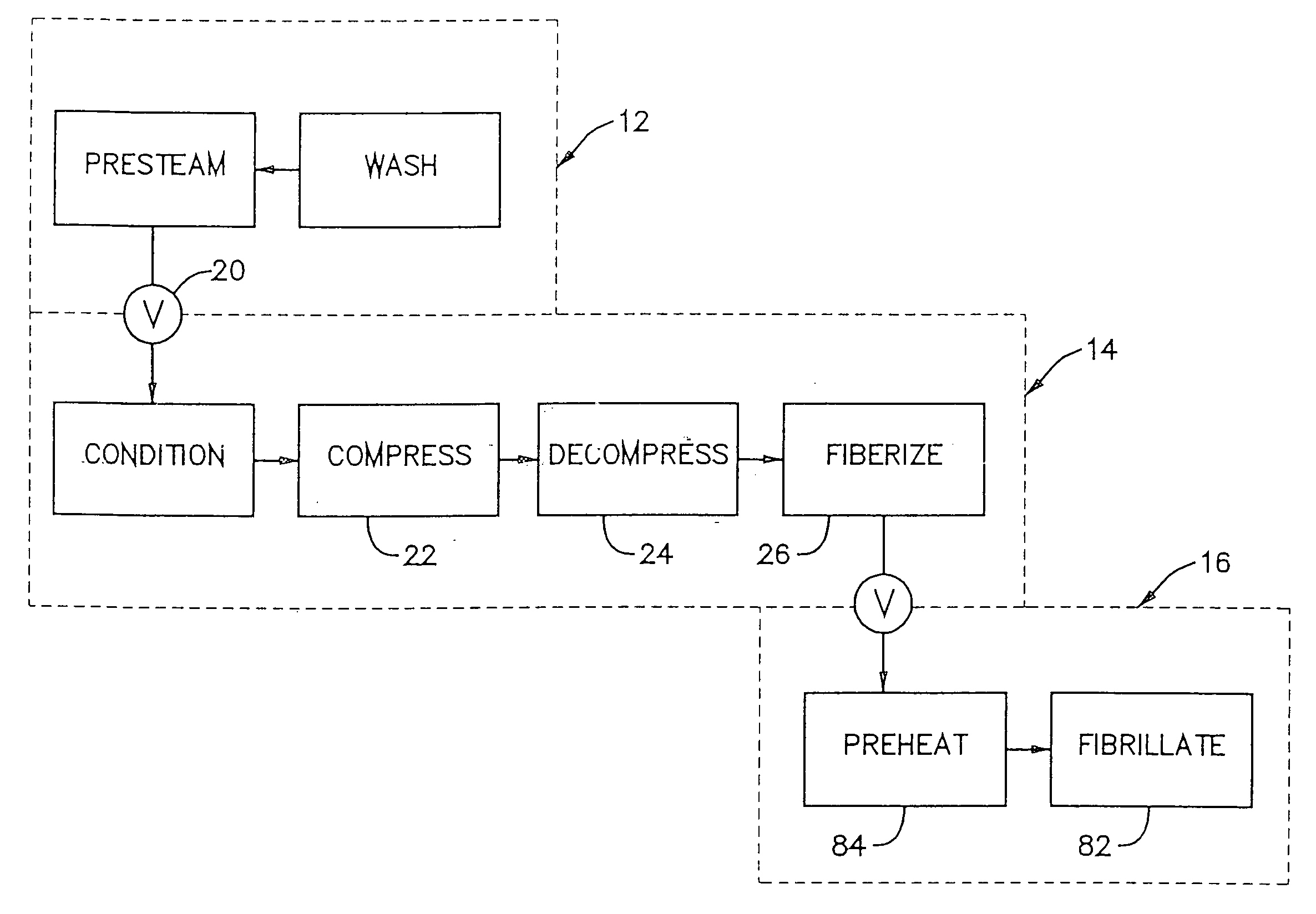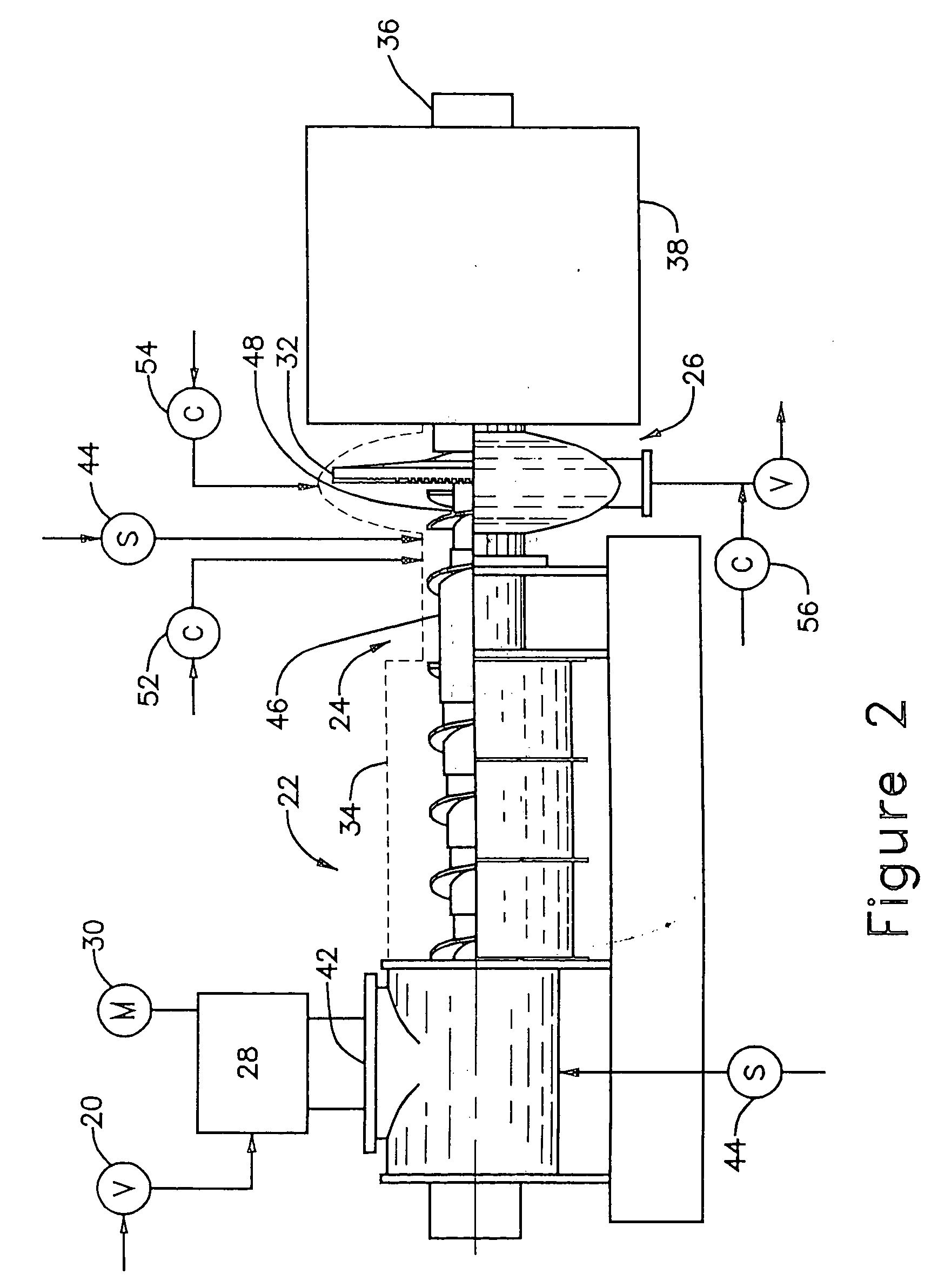High defiberization chip pretreatment
- Summary
- Abstract
- Description
- Claims
- Application Information
AI Technical Summary
Benefits of technology
Problems solved by technology
Method used
Image
Examples
example 1
[0063]FIGS. 6-13 graphically present the results of a pilot plant investigation of a pulp papermaking system as generally depicted in FIG. 1. The wood furnish used in the study was Black Spruce. The reference system utilized the RT Pressafiner pretreatment of the type described in International Application PCT / US98 / 14710, having the conditioning and compression at elevated temperature and pressure wherein less than 25 percent of the fibers are axially separated, whereupon these pretreated chips were fed to an RTS type primary refiner operating at 2300 rpm. This reference configuration is indicated as “RT-RTS”.
[0064] The pilot system according to the present invention is represented by RTF-RTS, in which the preprocessing 12 and primary refining 16 were in the same equipment as for the reference RT-RTS runs. The number serving as the suffix to “RTF” indicates the speed of rotation of the fiberizing disc according to the invention. For both the reference runs and the runs according to...
example 2
[0068]FIG. 9 is a bar graph showing a comparison of the effect on specific energy to achieve a freeness of 200 ml when the disc rotation speed on the high intensity, primary refiner is changed. The first bar is for the reference RT-RTS run with the primary refiner running at 2300 rpm, the required energy is 2277 KWH / ODMT. Implementation of the present invention for wood chip feed material pretreatment when processed further with the primary refiner running at 2300 rpm, required 1970 KWH / ODMT. With the reference RT-RTS running with a primary refiner at 2600 rpm, the required energy is 2023 KWH / ODMT, whereas when the inventive pretreatment is employed upstream of the primary refiner running at 2600 rpm, the required energy is 1830 KWH / ODMT. These data confirm that the beneficial effect of the pretreatment according to the invention can be realized over a range of high intensity primary refining speeds.
[0069]FIG. 10 compares the tear index results for the refiner series presented in F...
example 3
[0070]FIG. 11 represents results of a further investigation in which the specific energy applied to the fiberizer refiner was reduced by approximately 40%. The fiberizer disc speed for the pretreatment system was maintained at 1500 rpm and the high intensity primary refiner maintained at 2300 rpm, but with the plate pattern intensity in the primary refiner being varied. Referring to FIG. 11, the suffix (hb) refers to primary refiner plates operating in holdback direction (low intensity) and the suffix (ex) refers to primary refiner-plates operating in expelling direction (high intensity). Each of the four refiner series produced according to the invention (RTF−) had a lower energy requirement than the reference (RT−), regardless of operating with low or high intensity plates. The pulps produced with the high intensity plates (ex) had the lowest energy requirements.
[0071]FIG. 12 compares the tear index results for the refiner series presented in FIG. 11. The three refiner series pro...
PUM
| Property | Measurement | Unit |
|---|---|---|
| Fraction | aaaaa | aaaaa |
| Fraction | aaaaa | aaaaa |
| Fraction | aaaaa | aaaaa |
Abstract
Description
Claims
Application Information
 Login to View More
Login to View More - R&D
- Intellectual Property
- Life Sciences
- Materials
- Tech Scout
- Unparalleled Data Quality
- Higher Quality Content
- 60% Fewer Hallucinations
Browse by: Latest US Patents, China's latest patents, Technical Efficacy Thesaurus, Application Domain, Technology Topic, Popular Technical Reports.
© 2025 PatSnap. All rights reserved.Legal|Privacy policy|Modern Slavery Act Transparency Statement|Sitemap|About US| Contact US: help@patsnap.com



